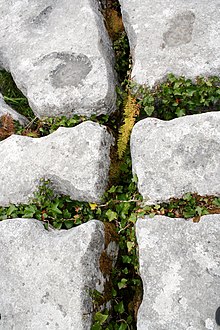Cleft cart

A cleft cart is a first-order cart structure . It arises in karst areas through solution weathering along vertical discontinuities in the rock.
history
The more detailed scientific description of Kluftkarren, engl. grikes or cutters , begins in 1900 with M. Eckert and in 1904 with E. Chaix. It was followed by HG Lindner in 1930, Alfred Bögli in 1960 , MM Sweeting in 1966, A. Pluhar & DC Ford in 1970 and K. Wirth in 1978. A more recent work is by Helen S. Goldie from 2008.
description

Fissured carts are, as the name implies, tied to crevices , cracks, fractures or other vertical discontinuities in the karst rock. They are usually more or less perpendicular to flat carts and, like them, are first-order cart structures. Cleft carts show a wedge-shaped shape in profile, they are much wider on the surface than in the depth. Only in the case of narrower cleft barrows is this wedge profile straight, while larger cleft barrows widen like a trumpet on the surface. Rift barrows can be completely filled with soil , but vegetation is often only found in lower elevations; many cleft carts are also completely empty. Jugular carts start at hairline cracks in the submillimeter to millimeter range and can expand up to the meter range. In their length dimension they reach tens of meters, often several meters in depth.
Cleft carts are usually associated with cart structures of the second or third order, mostly with grooved carts or gully carts , which can themselves be impressed over by cup carts or solution ripples . If the flat carts are covered on the surface with round carts, these lead over into vertical channel carts when they reach the edge. Often cleft carts are also covered with horizontally running solution ripples.
Emergence
Fissure carts can be built in bare rock or under ground cover. There is no doubt that rift carts are created through a combination of chemical solution weathering and hydrodynamic flow processes. The basic condition for their formation, however, is the existence of a network of vertical discontinuities in the rock, which enable the precipitation that collects on the flat carts to be selectively etched into deeper areas. The downward tapering wedge-shaped profile of the fissures shows that differential dissolution processes are at work and that the local dissolution speed gradually decreases downwards. The convex shape of mature fractured carts also indicates that this decrease in the speed of solution does not remain constant with depth and is not a linear function. The mass transfer taking place in a boundary layer covering the rock is maximally directly at the surface and decreases with increasing depth.
meaning
Cleft carts penetrate at least one sediment bank, but can penetrate much further into the stratified structure. In karst areas they are therefore structures of fundamental importance, as they create the principal drainage routes to the underlying epicarst, to sinkholes , to underground cave systems and rivers. However, their importance in channeling the surface drainage should not be underestimated.
Occurrence

Cleft carts are mainly found in Limestone and the Dolomites , so their occurrence is worldwide. Fine examples of cleft barrows can be found in the carbonic limestone at Malham Tarn or at Buttertubs Pass in Yorkshire and in the Burren in Ireland , in the Giant Grikeland in Australia and in El Torcal de Antequera in Spain .
See also
literature
- JRL Allen: Sedimentary structures - their character and physical basis . Elsevier, 1984, ISBN 0-444-42232-3 .
Individual evidence
- ↑ M. Eckert: Wiss. Supplement. Z. Dtsch.-Österr. Alpenver. tape 31 , 1900, pp. 52-60 .
- ↑ E. Chaix: Globe . tape 44 . Geneva, S. 49-60 .
- ^ Helen S. Goldie: Kluftkarren or grikes as fundamental karstic phenomena . In: Karst Rock Features, Karren Sculpturing . 2008 (English).
- ^ AD Howard: Bull. Natl. Speleol. Soc. tape 25 , 1963, pp. 45-65 .
- ↑ JT Parry: Can. Geogr. No. 1 , 1960, p. 14-21 .
- ↑ JN Jennings: Karst . Massachusetts Institute of Technology Press, Cambridge, Mass. 1971.